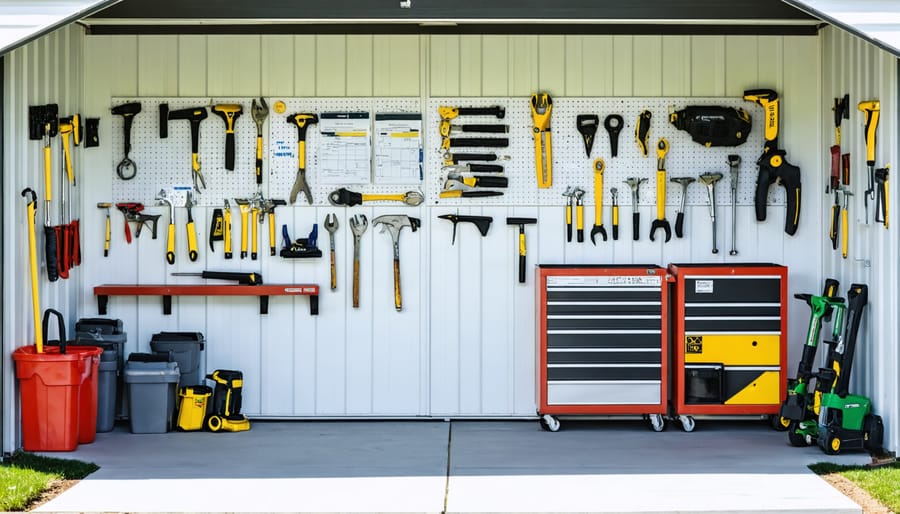Make Your Shed Organization Effortless with a Simple Inventory Sheet

An inventory management sheet transforms how you organize a shed effectively, acting as your central command center for tracking every item in your storage space. This simple yet powerful tool eliminates the frustration of searching for misplaced items and prevents unnecessary duplicate purchases. By listing each tool, supply, and piece of equipment alongside its exact location, quantity, and condition, you’ll maintain perfect control over your shed’s contents. Whether you’re a weekend DIY enthusiast or a serious homeowner managing multiple storage spaces, an inventory management sheet serves as your roadmap to perfect organization, ensuring every item is accounted for and easily accessible when needed. Think of it as your shed’s personal database – one that transforms chaos into order while saving you both time and money.
What is a Shed Inventory Management Sheet?

Core Components of an Inventory Sheet
An effective inventory management sheet consists of several key components that work together to help you track and organize your shed’s contents. At its heart, every inventory sheet should include a detailed item list with clear, specific descriptions that make it easy to identify each stored item. Alongside descriptions, you’ll want to include the quantity of each item, which helps you maintain optimal stock levels and know when it’s time to restock or declutter.
Location markers are another crucial element, indicating exactly where items can be found in your shed. This could be as simple as “back wall, top shelf” or a more detailed grid system using numbers and letters. Including the condition of items helps you track which tools or materials might need maintenance or replacement soon.
A date tracking system is invaluable for monitoring when items were added, last used, or need maintenance. For seasonal items, you might want to add notes about when they’re typically needed throughout the year. Including categories or tags helps group similar items together, making it easier to find what you need quickly.
Consider adding a basic value column to track the worth of your stored items for insurance purposes. A notes section provides space for important details like maintenance schedules, warranty information, or special storage requirements. For items you frequently restock, including minimum quantity alerts helps ensure you never run out of essential supplies.
Remember to leave room for updates and adjustments – your inventory sheet should be a living document that evolves with your storage needs. These core components create a comprehensive system that makes managing your shed’s contents both efficient and stress-free.
Creating Your Perfect Shed Inventory Sheet
Digital vs. Paper Tracking
In today’s digital age, you have two main options for tracking your shed inventory: digital spreadsheets and traditional paper methods. Both approaches can work effectively as part of your smart storage solutions, but each has its unique advantages.
Digital tracking through spreadsheet applications like Excel or Google Sheets offers several benefits. You can access your inventory from anywhere using your smartphone, make quick updates, and easily share the information with family members. Digital sheets also allow you to sort items, create automatic calculations, and back up your data securely. Plus, you can set up reminder notifications for maintenance tasks or seasonal reorganization.
Paper tracking, while traditional, remains a practical choice for many shed owners. A physical inventory sheet posted inside your shed provides immediate visibility and doesn’t require technology to access. It’s particularly useful for quick reference and can be especially helpful for family members who prefer tangible records. Paper sheets are also weather-resistant when laminated and won’t fail during power outages.
Consider combining both methods for optimal results. Keep a master digital copy for comprehensive tracking and backup, while maintaining a simplified paper version in your shed for day-to-day reference. This hybrid approach ensures you get the best of both worlds while maintaining an organized and efficient storage system.

Making Your Inventory Sheet Work for You
Common Organization Categories
Organizing your shed inventory starts with establishing clear, logical categories that make sense for your storage needs. A common approach is to group items by their function or usage frequency. For example, create separate sections for gardening tools, power equipment, seasonal items, and maintenance supplies. This makes it easier to protect your stored tools and track their locations.
Consider categorizing items as follows:
– Gardening Section: Shovels, rakes, pruning shears, and plant care supplies
– Power Tools: Lawn mowers, leaf blowers, drills, and their accessories
– Seasonal Items: Holiday decorations, winter equipment, summer furniture
– Hardware: Nails, screws, brackets, and other small components
– Chemicals: Fertilizers, pesticides, and cleaning supplies
– Sports Equipment: Bikes, balls, and outdoor game sets
You might also want to create a “frequently used” category near the entrance for items you access regularly. This system helps maintain organization while ensuring easy access to your most-needed items. Remember to update these categories as your storage needs change throughout the year.

An inventory management sheet is your key to maintaining an organized and efficient storage space. By implementing this simple yet powerful tool, you’ll always know exactly what you have, where it’s located, and when it’s time to replace or reorganize items. Remember to keep your sheet updated regularly, whether digital or physical, and customize it to fit your specific needs. The time you invest in creating and maintaining your inventory system will pay off through reduced stress, better organization, and improved accessibility to your belongings. Start small if needed, but start today – you’ll be amazed at how much easier storage management becomes with a proper inventory system in place. Happy organizing!

